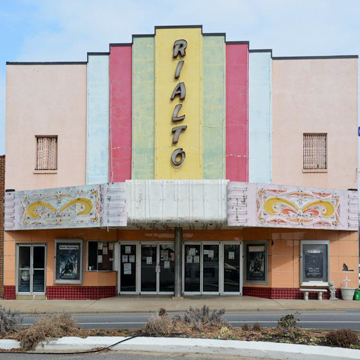The Rialto Theater is located on the courthouse square and has been in continuous operation since it replaced a theater torn down in 1923 to make way for this one. In 1940, the theater underwent an extensive remodeling at which time the present Art Deco neon-lit marquee and signage were added to the facade. The sixty-seven-foot vertical sign installed in November 1940 at the center of the facade has vertical staggered and stepped panels painted in four colors—blue, red, green, and yellow—and the neon-lit name of the theater runs vertically down the center panel. A marquee angles over the sidewalk and is neon lit with curved abstract designs. Built during segregation, the theater was given two entrances: one for white theatergoers, featuring double glass doors and recessed between peach-colored walls, and a smaller entrance beside it for African American patrons.
You are here
Rialto Theater
If SAH Archipedia has been useful to you, please consider supporting it.
SAH Archipedia tells the story of the United States through its buildings, landscapes, and cities. This freely available resource empowers the public with authoritative knowledge that deepens their understanding and appreciation of the built environment. But the Society of Architectural Historians, which created SAH Archipedia with University of Virginia Press, needs your support to maintain the high-caliber research, writing, photography, cartography, editing, design, and programming that make SAH Archipedia a trusted online resource available to all who value the history of place, heritage tourism, and learning.






